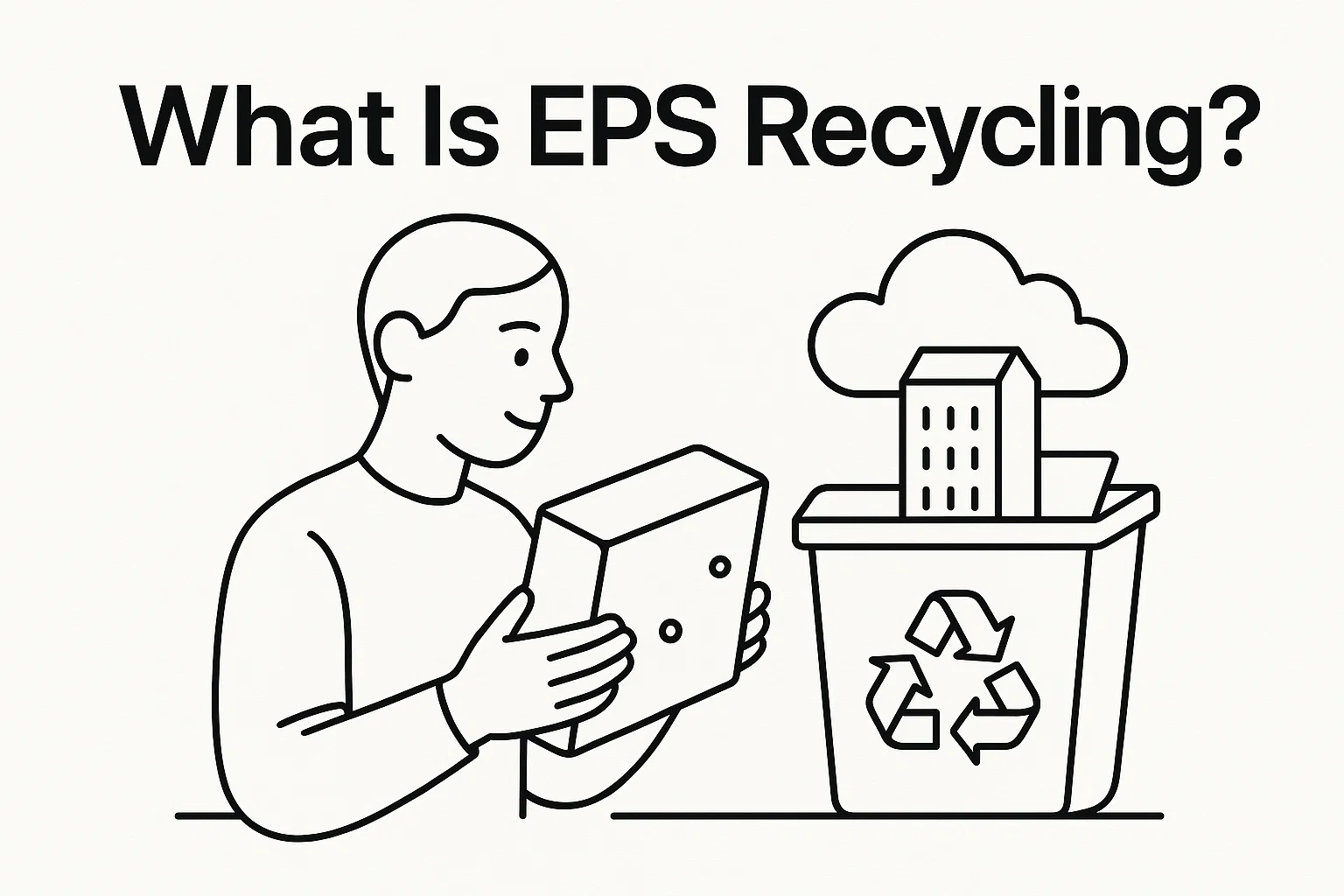If your facility handles large quantities of packaged goods, you are familiar with the bulky, white foam material used for cushioning and insulation. This material, expanded polystyrene (EPS), is essential for protecting products during transit. However, its disposal presents a significant operational and financial challenge. This guide explains the EPS recycling process and shows how investing in the right equipment, like an EPS recycling machine, can transform a costly waste problem into a profitable business opportunity.
Lets break down what you need to know.
Understanding Expanded Polystyrene (EPS) Foam
Expanded polystyrene is a rigid, closed-cell plastic foam. It is made from solid beads of polystyrene. The manufacturing process involves using steam to expand these beads, fusing them together inside a mold. The final product is remarkably lightweight because it is approximately 98% air. This property makes it an excellent material for packaging electronics, appliances, furniture, and for insulation in the construction industry.
While many people use the term “Styrofoam” interchangeably with EPS, it’s important to recognize that Styrofoam™ is a specific brand of extruded polystyrene (XPS) foam used primarily for building insulation and craft applications. The bulky white packaging material is almost always EPS. For businesses, the challenge is not its performance but its end-of-life management.
The Core Challenge: Why Is EPS Recycling Necessary?
Disposing of EPS foam creates major logistical and environmental headaches. The material’s primary drawback is its low density. It is mostly air, which means it takes up a massive amount of space in dumpsters and landfills relative to its weight.
Here are the specific problems this creates for businesses:
- High Waste Disposal Costs: Waste management companies often charge by volume, not weight. Because EPS is so bulky, it fills dumpsters quickly, leading to more frequent and expensive pickups. Transporting uncompacted foam to a landfill is inefficient, as trucks are essentially hauling air.
- Occupies Valuable Space: Storing large bags or piles of EPS waste consumes precious warehouse or facility space that could be used for revenue-generating activities.
- Environmental Pressure: EPS is not biodegradable and can persist in the environment for hundreds of years. Growing regulations and corporate social responsibility initiatives put pressure on companies to find sustainable alternatives to landfilling this material. Many municipalities are even banning EPS from landfills altogether, forcing businesses to find a new solution.
Effective EPS recycling directly addresses these challenges by tackling the root of the problem: its volume.
The Step-by-Step EPS Recycling Process Explained
The goal of EPS recycling is to remove the air and compact the polystyrene material into a dense, manageable form. This densified material becomes a valuable commodity that can be sold and used to manufacture new products. The process is straightforward and can be managed on-site with the right equipment.
Here is how it works.
Krok 1: Zbieranie i sortowanie
The first step is to gather the EPS waste. To ensure the final recycled material is high quality, it is important to keep the EPS clean and separate from other waste like cardboard, tape, and plastic wrap. Setting up designated collection points within your facility makes this stage simple and efficient. Different grades of EPS exist, but most commercial packaging foam (Grade A) is clean, white, and ideal for recycling.
Step 2: Volume Reduction with an EPS Recycling Machine
This is the most critical stage. The collected EPS foam is fed into an maszyna do recyklingu EPS. This equipment shreds the foam into smaller, more manageable pieces. After shredding, the machine uses immense pressure to compact the foam pieces, forcing out the air. This process can reduce the volume of the EPS waste by a ratio of up to 90:1. What once filled an entire dumpster can be condensed into a few small, dense blocks.
Step 3: Melting and Pelletizing
The compacted EPS blocks are then transported to a specialized recycling facility. Here, the blocks are melted under controlled conditions and extruded into thin strands. These strands are cooled and chopped into small, uniform pellets known as recycled polystyrene (PS) pellets or regranulate. This pellet form is the standard raw material used in plastics manufacturing.
Step 4: Creating New Products from Recycled Pellets
The recycled PS pellets are now a valuable commodity. Plastics manufacturers purchase these pellets to create a wide array of new, durable products. Common applications include picture frames, interior molding, coat hangers, park benches, and even some types of insulation. By participating in this process, your business helps create a closed-loop system, contributing directly to the circular economy.
The Key Technology: How EPS Recycling Machines Work
The transformation from bulky waste to a valuable asset is made possible by an maszyna do recyklingu EPS. These machines are the heart of any successful in-house EPS recycling program. They are designed to be robust, efficient, and simple to operate. For businesses, there are two primary types of machines to consider.
Cold Press Compactors: Efficient Volume Reduction
A cold press compactor, also known as a screw compactor, uses mechanical pressure to densify the EPS foam. Here is the process:
- Pianka EPS jest podawana do zbiornika maszyny.
- Rotating blades or shredders break the foam into small pieces.
- A large screw pushes the pieces forward, continuously compacting them under extreme pressure.
- The compressed material is forced out of an outlet, forming a dense, solid log or block.
This method is highly energy-efficient as it does not require heat. The resulting blocks are easy to stack, store, and transport. An maszyna do zagęszczania pianki EPS is an excellent solution for businesses with a steady stream of EPS waste, such as furniture stores, appliance retailers, and distribution centers.
Hot Melt Densifiers: Maximum Density for Transport
A hot melt densifier works similarly to a cold press compactor but adds a heating element to the process. The shredded foam is heated until it melts, which allows for an even greater compression ratio. The molten material is then extruded and cools into very dense, brick-like ingots. These ingots are heavier and take up even less space than cold-pressed blocks, which can further reduce transportation costs. This technology is ideal for large-scale operations or businesses located far from recycling buyers.
Choosing the Right Machine for Your Business Needs
Selecting the right machine depends on several factors:
- Volume of Waste: How much EPS does your business generate daily or weekly? This will determine the required capacity and throughput of the machine.
- Space Availability: Compactors are available in various sizes. Assess the floor space you can dedicate to the recycling operation.
- Logistical Considerations: Consider your proximity to buyers of recycled EPS. If transport distances are long, a hot melt densifier might offer a better return due to higher material density.
- Budget: These machines are a capital investment. Calculate the potential savings on waste disposal to determine your expected return on investment.
A reputable supplier like Maszyna Rumtoo can help you analyze these factors and recommend a machine that aligns with your operational needs and financial goals.
Uzasadnienie biznesowe dla inwestycji w recykling EPS
For a purchasing manager, the decision to invest in new equipment must be backed by a clear financial benefit. An EPS recycling program offers a compelling and multifaceted return on investment.
Drastically Reduce Waste Disposal and Landfill Fees
This is the most immediate and significant financial benefit. By compacting your EPS waste, you can reduce the number of dumpster pickups by 90% or more. For businesses spending thousands of dollars each month on waste management, these savings alone can ensure the EPS recycling machine pays for itself in a short period. You are no longer paying to transport air; you are efficiently managing a solid material.
Generate New Income by Selling Recycled EPS Blocks
Compacted EPS is not trash; it is a sought-after commodity. There is a stable market for recycled polystyrene. Companies will pay good money for clean, densified EPS blocks that they can process into pellets. This creates a new revenue stream for your business, turning a line item on your expense report into a source of income. The money gained from selling the material, combined with the savings on disposal fees, makes the financial case undeniable.
Achieve Corporate Sustainability & ESG Targets
In today’s market, environmental stewardship is not just a talking point; it is a core business value. Implementing an EPS recycling program is a tangible way to demonstrate your company’s commitment to sustainability. It helps you:
- Divert tons of waste from landfills.
- Reduce your company’s carbon footprint.
- Contribute to the circular economy.
- Enhance your brand’s reputation among eco-conscious customers and partners.
This can be a powerful differentiator in a competitive marketplace and is a critical component of meeting Environmental, Social, and Governance (ESG) goals.
Frequently Asked Questions About EPS Recycling
- Can you really recycle Styrofoam™?
Yes. While many municipal curbside programs do not accept it due to its low density, commercial EPS recycling is a well-established and effective process when the right equipment is used to compact the material first. - Is the process complicated to manage?
No. Modern EPS recycling machines are designed for ease of use. A single employee can be trained to operate the machine safely and efficiently as part of their regular duties. - What is the value of recycled EPS blocks?
The market price for recycled EPS fluctuates based on supply and demand, but it is a consistent commodity. The price is typically quoted per pound. Your machine supplier can often help connect you with buyers in your area. - Do we need a lot of space?
Not necessarily. While you need space for the machine itself, the overall area required for waste management will likely decrease. You will be replacing bulky bags of loose foam with neatly stacked, compact blocks.
Start Your Profitable Recycling Operation with Rumtoo Machine
Expanded Polystyrene waste is a problem that does not solve itself. Continuing to send bulky foam to the landfill is an expensive and unsustainable practice. By investing in an EPS recycling machine, you can take control of your waste stream, significantly cut operational costs, and create a new source of revenue.
The transition is more than an equipment upgrade; it is a strategic business decision that delivers financial returns and strengthens your company’s commitment to a sustainable future.
Ready to turn your EPS waste into a valuable asset? Contact the sales team at Maszyna Rumtoo today to discuss your specific needs and find the perfect EPS recycling solution for your business.

